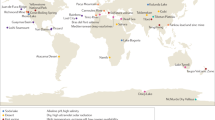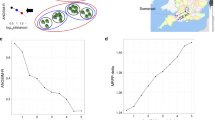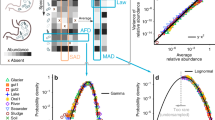Abstract
Marine microbial communities are engines of globally important processes, such as the marine carbon, nitrogen and sulphur cycles. Recent data on the structures of these communities show that they adhere to universal biological rules. Co-occurrence patterns can help define species identities, and systems-biology tools are revealing networks of interacting microorganisms. Some microbial systems are found to change predictably, helping us to anticipate how microbial communities and their activities will shift in a changing world.
This is a preview of subscription content, access via your institution
Access options
Subscribe to this journal
Receive 51 print issues and online access
$199.00 per year
only $3.90 per issue
Buy this article
- Purchase on Springer Link
- Instant access to full article PDF
Prices may be subject to local taxes which are calculated during checkout


Similar content being viewed by others
References
Whitman, W. B., Coleman, D. C. & Wiebe, W. J. Prokaryotes: the unseen majority. Proc. Natl Acad. Sci. USA 95, 6578–6583 (1998).
Pace, N. R., Stahl, D. A., Lane, D. L. & Olsen, G. J. The analysis of natural microbial populations by rRNA sequences. Adv. Microb. Ecol. 9, 1–55 (1986).
Pace, N. R. A molecular view of microbial diversity and the biosphere. Science 276, 734–740 (1997).
Angly, F. E. et al. The marine viromes of four oceanic regions. PLoS Biol. 4, e368 (2006).
Massana, R. & Pedrós-Alió, C. Unveiling new microbial eukaryotes in the surface ocean. Curr. Opin. Microbiol. 11, 213–218 (2008).
Giovannoni, S. J. & Stingl, U. Molecular diversity and ecology of microbial plankton. Nature 437, 343–348 (2005).
Baas Becking, L. G. M. Geobiologie of Inleiding tot de Milieukunde (Van Stockum & Zoon, 1934).
Pedrós-Alió, C. Marine microbial diversity: can it be determined? Trends Microbiol. 14, 257–263 (2006).
Martiny, J. B. H. et al. Microbial biogeography: putting microorganisms on the map. Nature Rev. Microbiol. 4, 102–112 (2006). This review combines ideas from microbial ecologists and 'macrobial' ecologists about how to include microorganisms in broader ecological theories and conceptual frameworks.
Foissner, W. Biogeography and dispersal of micro-organisms: a review emphasizing protists. Acta Protozool. 45, 111–136 (2006).
Ramette, A. & Tiedje, J. M. Biogeography: an emerging cornerstone for understanding prokaryotic diversity, ecology, and evolution. Microb. Ecol. 53, 197–207 (2007).
Fierer, N. in Accessing Uncultivated Microorgansims: From the Environment to Organisms and Genomes and Back (ed. Zengler, K.) 95–115 (ASM Press, 2008).
Fenchel, T. & Finlay, B. J. The ubiquity of small species: patterns of local and global diversity. Bioscience 54, 777–784 (2004).
Green, J. & Bohannan, B. J. Spatial scaling of microbial biodiversity. Trends Ecol. Evol. 21, 501–507 (2006).
Cottrell, M. T. & Kirchman, D. L. Contribution of major bacterial groups to bacterial biomass production (thymidine and leucine incorporation) in the Delaware estuary. Limnol. Oceanogr. 48, 168–178 (2003).
Malmstrom, R. R., Cottrell, M. T., Elifantz, H. & Kirchman, D. L. Biomass production and assimilation of dissolved organic matter by SAR11 bacteria in the Northwest Atlantic Ocean. Appl. Environ. Microbiol. 71, 2979–2986 (2005).
Sogin, M. L. et al. Microbial diversity in the deep sea and the underexplored 'rare biosphere'. Proc. Natl Acad. Sci. USA 103, 12115–12120 (2006).
Huber, J. A. et al. Microbial population structures in the deep marine biosphere. Science 318, 97–100 (2007). This is the second of two papers describing detailed analysis of microbial community structure in marine samples studied by a high-throughput sequencing technique.
Pommier, T. et al. Global patterns of diversity and community structure in marine bacterioplankton. Mol. Ecol. 16, 867–880 (2007).
Brown, M. V., Schwalbach, M. S., Hewson, I. & Fuhrman, J. A. Coupling 16S-ITS rDNA clone libraries and ARISA to show marine microbial diversity: development and application to a time series. Environ. Microbiol. 7, 1466–1479 (2005).
Capone, D. G., Zehr, J. P., Paerl, H. W., Bergman, B. & Carpenter, E. J. Trichodesmium, a globally significant marine cyanobacterium. Science 276, 1221–1229 (1997).
Zehr, J. P. & Ward, B. B. Nitrogen cycling in the ocean: new perspectives on processes and paradigms. Appl. Environ. Microbiol. 68, 1015–1024 (2002).
Montoya, J. P. et al. High rates of N2 fixation by unicellular diazotrophs in the oligotrophic Pacific Ocean. Nature 430, 1027–1031 (2004).
Cohan, F. M. What are bacterial species? Annu. Rev. Microbiol. 56, 457–487 (2002).
Staley, J. T. Biodiversity: are microbial species threatened? Curr. Opin. Biotechnol. 8, 340–345 (1997).
Moran, N. A., Munson, M. A., Baumann, P. & Ishikawa, H. A molecular clock in endosymbiotic bacteria is calibrated using the insect hosts. Proc. R. Soc. Lond. B 253, 167–171 (1993).
Degnan, P. H., Lazarus, A. B., Brock, C. D. & Wernegreen, J. J. Host–symbiont stability and fast evolutionary rates in an ant–bacterium association: cospeciation of Camponotus species and their endosymbionts, Candidatus blochmannia . Syst. Biol. 53, 95–110 (2004).
Brown, M. V. & Fuhrman, J. A. Marine bacterial microdiversity as revealed by internal transcribed spacer analysis. Aquat. Microb. Ecol. 41, 15–23 (2005).
Garcia-Martinez, J. & Rodriguez-Valera, F. Microdiversity of uncultured marine prokaryotes: the SAR11 cluster and the marine Archaea of Group I. Mol. Ecol. 9, 935–948 (2000).
Acinas, S. G. et al. Fine-scale phylogenetic architecture of a complex bacterial community. Nature 430, 551–554 (2004).
Prosser, J. I. et al. The role of ecological theory in microbial ecology. Nature Rev. Microbiol. 5, 384–392 (2007). This paper shows why the ongoing molecular revolution in microbial ecology needs to be driven by theory, and that the generality of established ecological theory must be tested using microbial systems.
Pianka, E. R. Latitudinal gradients in species diversity: a review of concepts. Am. Nat. 100, 33–46 (1966).
Rosenweig, M. L. Species Diversity in Space and Time (Cambridge Univ. Press, 1995).
Hillebrand, H. On the generality of the latitudinal diversity gradient. Am. Nat. 163, 192–211 (2004).
Hillebrand, H. Strength, slope and variability of marine latitudinal gradients. Mar. Ecol. Prog. Ser. 273, 251–267 (2004).
Fierer, N. & Jackson, R. B. The diversity and biogeography of soil bacterial communities. Proc. Natl Acad. Sci. USA 103, 626–631 (2006).
Fuhrman, J. A. et al. A latitudinal diversity gradient in planktonic marine bacteria. Proc. Natl Acad. Sci. USA 105, 7774–7778 (2008).
Horner-Devine, M. C., Lage, M., Hughes, J. B. & Bohannan, B. J. A taxa–area relationship for bacteria. Nature 432, 750–753 (2004).
Woodcock, S. et al. Taxa–area relationships for microbes: the unsampled and the unseen. Ecol. Lett. 9, 805–812 (2006).
Hewson, I., Steele, J. A., Capone, D. G. & Fuhrman, J. A. Remarkable heterogeneity in meso- and bathypelagic bacterioplankton assemblage composition. Limnol. Oceanogr. 51, 1274–1283 (2006).
Gotelli, N. J. & Graves, G. R. Null Models in Ecology (Smithsonian Institution Press, 1996).
Gotelli, N. J. & McCabe, D. J. Species co-occurrence: a meta-analysis of J. M. Diamond's assembly rules model. Ecology 83, 2091–2096 (2002).
Woodcock, S. et al. Neutral assembly of bacterial communities. FEMS Microbiol. Ecol. 62, 171–180 (2007).
Horner-Devine, M. C. et al. A comparison of taxon co-occurrence patterns for macro- and microorganisms. Ecology 88, 1345–1353 (2007).
Ruan, Q. S. et al. Local similarity analysis reveals unique associations among marine bacterioplankton species and environmental factors. Bioinformatics 22, 2532–2538 (2006).
Fuhrman, J. A. & Steele, J. A. Community structure of marine bacterioplankton: patterns, networks, and relationships to function. Aquat. Microb. Ecol. 53, 69–81 (2008).
Morris, R. M. et al. Temporal and spatial response of bacterioplankton lineages to annual convective overturn at the Bermuda Atlantic Time-series Study site. Limnol. Oceanogr. 50, 1687–1696 (2005).
Montoya, J. M., Pimm, S. L. & Sole, R. V. Ecological networks and their fragility. Nature 442, 259–264 (2006).
Long, R. A. & Azam, F. Antagonistic interactions among marine pelagic bacteria. Appl. Environ. Microbiol. 67, 4975–4983 (2001).
Davidov, Y., Friedjung, A. & Jurkevitch, E. Structure analysis of a soil community of predatory bacteria using culture-dependent and culture-independent methods reveals a hitherto undetected diversity of Bdellovibrio-like organisms. Environ. Microbiol. 8, 1667–1673 (2006).
Fuhrman, J. & Hagström,, Å. in Microbial Ecology of the Oceans (ed. Kirchman, D.) 45–90 (Wiley, 2008).
Not, F., Gausling, R., Azam, F., Heidelberg, J. F. & Worden, A. Z. Vertical distribution of picoeukaryotic diversity in the Sargasso Sea. Environ. Microbiol. 9, 1233–1252 (2007).
Massana, R. et al. Phylogenetic and ecological analysis of novel marine stramenopiles. Appl. Environ. Microbiol. 70, 3528–3534 (2004).
Countway, P. D. et al. Distinct protistan assemblages characterize the euphotic zone and deep sea (2500 m) of the western North Atlantic (Sargasso Sea and Gulf Stream). Environ. Microbiol. 9, 1219–1232 (2007).
Suttle, C. A. Marine viruses — major players in the global ecosystem. Nature Rev. Microbiol. 5, 801–812 (2007).
Angly, F. E. et al. The marine viromes of four oceanic regions. PLoS Biol. 4, e368 (2006).
Bench, S. R. et al. Metagenomic characterization of Chesapeake bay virioplankton. Appl. Environ. Microbiol. 73, 7629–7641 (2007).
Achtman, M. & Wagner, M. Microbial diversity and the genetic nature of microbial species. Nature Rev. Microbiol. 6, 431–440 (2008). This paper brings together many viewpoints on the definitions and nature of microbial species.
Koeppel, A. et al. Identifying the fundamental units of bacterial diversity: a paradigm shift to incorporate ecology into bacterial systematics. Proc. Natl Acad. Sci. USA 105, 2504–2509 (2008).
Hunt, D. E. et al. Resource partitioning and sympatric differentiation among closely related bacterioplankton. Science 320, 1081–1085 (2008).
Fuhrman, J. A. et al. Annually reoccurring bacterial communities are predictable from ocean conditions. Proc. Natl Acad. Sci. USA 103, 13104–13109 (2006). This paper shows the predictability of marine microbial communities studied over a period of years, implying many features similar to familiar animal and plant systems.
Wommack, K. E. & Colwell, R. R. Virioplankton: viruses in aquatic ecosystems. Microbiol. Mol. Biol. Rev. 64, 69–114 (2000).
Fuhrman, J. A. Marine viruses: biogeochemical and ecological effects. Nature 399, 541–548 (1999).
Suttle, C. A. Viruses in the sea. Nature 437, 356–361 (2005).
Kettler, G. C. et al. Patterns and implications of gene gain and loss in the evolution of Prochlorococcus . PLoS Genet. 3, 2515–2528 (2007).
Thingstad, T. F. & Lignell, R. Theoretical models for the control of bacterial growth rate, abundance, diversity and carbon demand. Aquat. Microb. Ecol. 13, 19–27 (1997).
Fuhrman, J. A. & Suttle, C. A. Viruses in marine planktonic systems. Oceanography 6, 51–63 (1993).
Johnson, Z. I. et al. Niche partitioning among Prochlorococcus ecotypes along ocean-scale environmental gradients. Science 311, 1737–1740 (2006).
Beja, O. et al. Bacterial rhodopsin: evidence for a new type of phototrophy in the sea. Science 289, 1902–1906 (2000).
Fuhrman, J. A., Schwalbach, M. S. & Stingl, U. Proteorhodopsins: an array of physiological roles? Nature Rev. Microbiol. 6, 488–494 (2008).
Tyson, G. W. et al. Community structure and metabolism through reconstruction of microbial genomes from the environment. Nature 428, 37–43 (2004).
Hewson, I. & Fuhrman, J. A. Richness and diversity of bacterioplankton species along an estuarine gradient in Moreton Bay, Australia. Appl. Environ. Microbiol. 70, 3425–3433 (2004).
Quince, C., Curtis, T. P. & Sloan, W. T. The rational exploration of microbial diversity. ISME J. 2, 997–1006 (2008).
Rusch, D. B. et al. The Sorcerer II Global Ocean Sampling expedition: northwest Atlantic through eastern tropical Pacific. PLoS Biol. 5, e77 (2007).
Hewson, I., Steele, J. A., Capone, D. G. & Fuhrman, J. A. Temporal and spatial scales of variation in bacterioplankton assemblages of oligotrophic surface waters. Mar. Ecol. Prog. Ser. 311, 67–77 (2006).
Franklin, M. P. et al. Bacterial diversity in the bacterioneuston (sea surface microlayer): the bacterioneuston through the looking glass. Environ. Microbiol. 7, 723–736 (2005).
Fuhrman, J. A. in Manual of Environmental Microbiology 3rd edn (eds Hurst, C. J. et al.) Ch. 35 (ASM Press, 2007).
Ramette, A. Multivariate analyses in microbial ecology. FEMS Microbiol. Ecol. 62, 142–160 (2007).
Chao, A., Chazdon, R. L., Colwell, R. K. & Shen, T. J. Abundance-based similarity indices and their estimation when there are unseen species in samples. Biometrics 62, 361–371 (2006).
Acknowledgements
I thank Å. Hagström, F. Sun, J. Steele, I. Hewson, S. Naeem, J. Green and J. Brown for helping develop ideas presented here, and C. Chow, C. Horner-Devine and J. Cram for comments. Work in my laboratory was supported by the US National Science Foundation Microbial Observatories Program and grants 0527034, 0623575, 0648581, and 0703159, and by the University of Southern California Wrigley Institute for Environmental Studies.
Author information
Authors and Affiliations
Ethics declarations
Competing interests
The author declares no competing financial interests.
Additional information
Reprints and permissions information is available at http://www.nature.com/reprints.
Correspondence should be addressed to the author (fuhrman@usc.edu).
Rights and permissions
About this article
Cite this article
Fuhrman, J. Microbial community structure and its functional implications. Nature 459, 193–199 (2009). https://doi.org/10.1038/nature08058
Published:
Issue Date:
DOI: https://doi.org/10.1038/nature08058
This article is cited by
-
Exploring Soil Bacterial Diversity in Relation to Edaphic Physicochemical Properties of High-altitude Wetlands from Argentine Puna
Microbial Ecology (2024)
-
High nitrogen fertilizer input enhanced the microbial network complexity in the paddy soil
Soil Ecology Letters (2024)
-
Spread and persistence of the invasive dinoflagellate Ceratium furcoides (Levander) Langhans through South America: watersheds in Rio Grande do Sul, Brazil
Aquatic Sciences (2024)
-
Erosion and deposition significantly affect the microbial diversity, co-occurrence network, and multifunctionality in agricultural soils of Northeast China
Journal of Soils and Sediments (2024)
-
Gravesoil fungi are more sensitive than bacteria in response to precipitation
Soil Ecology Letters (2024)
Comments
By submitting a comment you agree to abide by our Terms and Community Guidelines. If you find something abusive or that does not comply with our terms or guidelines please flag it as inappropriate.



